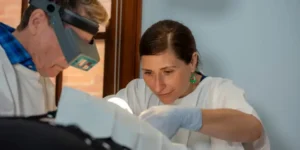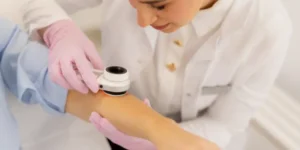Have you ever noticed a new spot on your skin and wondered if it could be serious? Skin cancer is the most common type of cancer in Australia, with more than 13,000 cases each year, according to Cancer Council Australia. A routine skin check catches concerns early. A regular skin cancer screening ensures that any skin changes are detected when intervention is easiest. Early detection is essential.
What Is Skin Cancer Screening?

Skin cancer screening is a medical check that looks for signs of skin cancer before symptoms occur. A doctor skilled in skin cancer care examines your skin from head to toe. They use bright lights and a tool called a dermatoscope to reveal hidden skin lesions. The exam is quick and painless.
Your doctor inspects every part of your body—even areas rarely hit by sun exposure. They search for unusual spots, moles that change in size or shape, and other skin lesions of concern. If something looks different, a small skin biopsy may be performed to test the tissue.
https://www.youtube.com/embed/qBjlOGGTAvs
Watch: Skin Cancer Screening Overview
Why Early Detection Is Crucial
Catching skin cancer early improves treatment and survival rates. Melanoma—the most dangerous type—has a 99% five-year survival rate when diagnosed in its first stages. This rate plummets to 27% if the cancer spreads. Early skin checks lead to simpler procedures and fewer complications.
Small skin cancers often need just a minor removal without a hospital stay. Delaying a screening can result in major surgery, scarring, and treatments that leave you feeling unwell. Quick, regular checks help you beat sun damage and lower your risk.
https://www.youtube.com/embed/sbEQ9eWTPRQ
Watch: The Importance of Early Detection
Who Is at Higher Risk for Skin Cancer?
Certain people face a higher chance of developing skin cancer. Those with fair skin, light eyes, and a tendency to burn from sun exposure are in the risk group. A family history of melanoma further elevates the risk. Past sunburns, numerous moles, and prolonged sun exposure increase the odds.
Older individuals and those with weakened immune systems should take extra care. Even people with darker skin can develop nonmelanoma skin cancer, though it is less common. Regular skin checks are crucial in a country with intense ultraviolet (uv) radiation.
https://www.youtube.com/embed/a60u-OixgJ4
Watch: Understanding Risk Factors
Common Types of Skin Cancer
Three main types of skin cancer exist. Basal cell carcinoma (bcc) usually shows as shiny bumps or pink patches. It grows slowly and rarely spreads. Squamous cell carcinoma (scc) appears as red, scaly patches or open sores on sun-exposed skin, such as the face or hands.
Malignant melanoma may develop from changing moles, with varied colours and uneven edges. Use the ABCDE guide: look for Asymmetry, irregular Borders, Colour changes, Diameter over 6mm, and Evolution over time. Less common forms, like nodular melanoma and Merkel cell carcinoma, require prompt care.
Key Signs to Look For During a Skin Check
Regular self-checks allow you to catch warning signs early. Notice any new spots that suddenly appear. Keep an eye on moles that change in size, shape, or colour. Comparing spots to each other can highlight the odd one out.
- New spots or moles may signal a problem.
- Changes in size, shape, or colour demand attention.
- Spots that look different from the rest should be examined.
- Sores that do not heal within 4-6 weeks can be concerning.
- Redness or swelling around a spot might indicate trouble.
- Itchiness, pain, or tenderness lasting over a week calls for a check.
- Oozing, bleeding, or crusting spots need prompt evaluation.
- Scaly patches or persistent areas of dryness are early clues.
- Shiny bumps or nodules can point to basal cell carcinoma.
- Dark spots under nails may be a rare sign of melanoma.
The ABCDE Guide for Detecting Melanoma
Early detection of melanoma is key. The ABCDE guide helps you focus on skin changes. Watch for:
- A is for Asymmetry: One half does not mirror the other.
- B is for Border: Edges that are uneven or blurred.
- C is for Colour: Multiple hues, such as brown, black, red, blue, or white, in one spot.
- D is for Diameter: Spots larger than 6mm warrant a closer look.
- E is for Evolving: Any spot that changes over time is suspect.
- New spots emerging after age 30 are worth monitoring.
- Sore spots that persist for over three weeks need evaluation.
- Itchy or painful moles are not the norm.
- Bleeding spots without injury should be checked immediately.
- Raised or lumpy areas that appear suddenly may be dangerous.
How to Perform a Self-Skin Check
Doing a monthly skin check takes about 10 minutes and is very helpful. Find a bright, quiet space and position a full-length mirror so you see your whole body. Use a hand mirror for tricky spots.
Steps for Monitoring Your Skin
- Select a bright space each month.
- Stand before a full-length mirror to view your entire body. Use a hand mirror for hard-to-see areas.
- Start at your head and steadily move toward your toes.
- Examine less visible spots, such as the scalp, behind the ears, and under nails.
- Pay close attention to moles and any skin changes.
- Snap photographs if you need to track changes over time.
- Remember the ABCDE rule for detecting melanoma.
- Focus on sun-exposed areas like the face, neck, arms, and hands.
- Ask a family member or friend to help with areas like your back.
- Mark a recurring date each month to perform your skin check.
- Jot down any changes to discuss with your doctor.
- Visit a skin specialist every year, or as recommended if you have risk factors for skin cancer.
- Examine skin of all types, as cancer can develop even on darker skin.
- Learn what your normal skin looks like to catch differences quickly.
- Inspect skin folds and hidden areas carefully.
Areas of the Body to Pay Attention To
- Scalp and hairline – Part your hair to see all areas of your scalp.
- Face and ears – Look closely at your nose, cheeks, and behind and inside your ears.
- Neck and chest – Check both the front and sides. Women should lift breasts to inspect the underlying skin.
- Back and shoulders – Use a hand mirror to inspect these sun-exposed spots.
- Arms and hands – Look between your fingers and under nails carefully.
- Legs and feet – Pay attention to areas between toes and on the soles.
- Buttocks and genital area – Even areas rarely seen can show skin changes.
- Armpits – Check the folds where skin may hide damage.
- Eyes and eyelids – Use a mirror to inspect the delicate skin around your eyes.
- Lips and mouth – Feel along your lips and inside your mouth for rough patches.
- Palms and soles – These thick areas can harbor unusual signs.
- Between fingers and toes – Small spots can hide in tight corners.
Professional Skin Cancer Screening Exams
A professional screening goes beyond a simple self-check. A trained doctor examines your entire body with advanced tools such as epiluminescence microscopy. This method detects early skin changes that may be missed when you check at home.
What to Expect During a Screening
- Your doctor reviews your health history, including past sun exposure and a family history of melanoma.
- You change into a gown that allows a thorough examination.
- The doctor inspects every part of your skin, even areas often unseen.
- Advanced tools like a dermatoscope help reveal subtle skin changes.
- Photos may be taken to monitor spots over time.
- The full-body exam lasts about 15-20 minutes.
- If necessary, your doctor may measure a suspicious spot or perform a skin biopsy.
- The biopsy procedure involves numbing a small area before a tiny sample is taken.
- Results usually come back quickly so that you can discuss the next steps.
- Your doctor will also demonstrate effective self-check techniques using the ABCDE guide.
- Many screenings are covered by Medicare once you get a referral.
- Sun protection tips are provided based on your skin type and risk factors.
Benefits of Regular Skin Cancer Checks
Routine skin checks help catch cancer early when treatment is simpler and more effective. Early diagnosis improves cure rates and avoids the need for complex procedures. A small check can make a big difference in your overall health.
Early Diagnosis Leads to Better Outcomes
Spotting skin cancer in its early stages enhances your treatment options. A tiny malignant melanoma may only require a simple removal if caught early. When cancer advances, treatment becomes much tougher.
The numbers show a clear benefit. Early detection of melanoma can lead to over a 98% five-year survival rate. Waiting too long reduces that rate significantly. A quick skin check can really buy you time.
Peace of Mind and Prevention
Regular skin checks ease worry. Knowing your skin is under watch helps you feel secure. Detecting a problem early often means less invasive treatment and a smoother recovery. Staying proactive against sun damage and skin lesions keeps you on the safe side.
Myths About Skin Cancer Screening
Many myths circulate about skin cancer checks. Some say screenings are painful or expensive. This is simply not true. Most skin checks take only minutes and are often covered by Medicare.
\Another common myth is that screenings are only needed for older adults. Skin cancer can affect anyone, even teenagers. Some assume that tanned skin protects against cancer, but all skin types can be at risk. Even during cooler months, ultraviolet (uv) radiation can cause skin damage.
Some avoid screenings for fear of bad news. Getting a check can ease worries. Early detection makes treatment easier. The experts at Skin Cancer Hub see time and again that prompt action makes all the difference.
Tips for Staying Sun-Safe Year-Round
Protecting your skin from sun damage is important every day. Use sunscreen with SPF 30+ on all exposed areas. Make sure to reapply after swimming or sweating.
- Apply sunscreen daily. Choose a lotion with SPF 30+ to shield against harmful uv radiation.
- Wear clothing that covers your arms and legs. Opt for materials with sun protection ratings.
- Don a wide-brimmed hat to protect your face, ears, and neck from the sun.
- Use sunglasses that block 100% of uv radiation to safeguard your eyes.
- Seek shade during peak sun hours between 10 AM and 4 PM.
- Check the uv index with your weather app or refer to updates from Cancer Council Australia.
- Be cautious near reflective surfaces like water, sand, or snow.
- Keep young children out of direct sunlight since their skin is very delicate.
- Consider window tint to reduce uv exposure indoors and in vehicles.
- Perform a monthly skin check to spot new or raised spots early.
- Drink plenty of water when outdoors to keep your skin healthy.
- Arrange an annual check-up with your doctor, especially if you face risk factors for skin cancer.
Conclusion
Your skin tells its own story. Regular checks can catch cancer early, just when treatment is easiest. If you notice changes, get them checked without delay.
Keep skin checks as part of your routine, like a visit to the dentist or a flu shot. The team at Skin Cancer Hub uses modern, advanced tools to detect skin changes early and accurately. A small step today can protect you in a big way.
Choosing the Best Skin Cancer Clinic
Finding the right clinic for skin cancer screenings is important. Not all clinics provide the same level of care or use advanced equipment.
At Skin Cancer Hub in Woolloongabba at 61 Ipswich Rd in Brisbane, Queensland, a purpose-built facility awaits you. Our experienced doctors offer complete care in the detection, diagnosis, treatment, and management of skin cancer and melanoma.
Our modern facility features dedicated operating theatres, treatment rooms, and new equipment.





